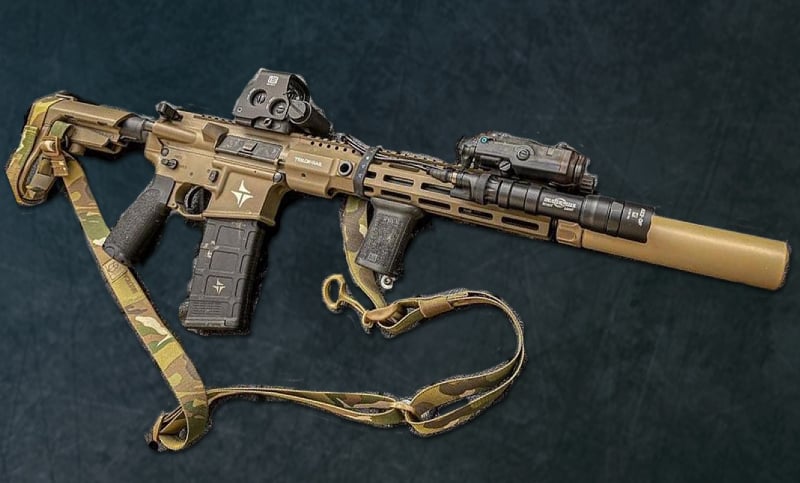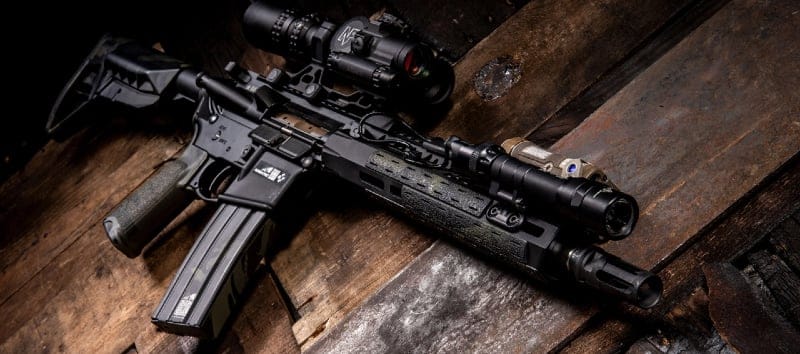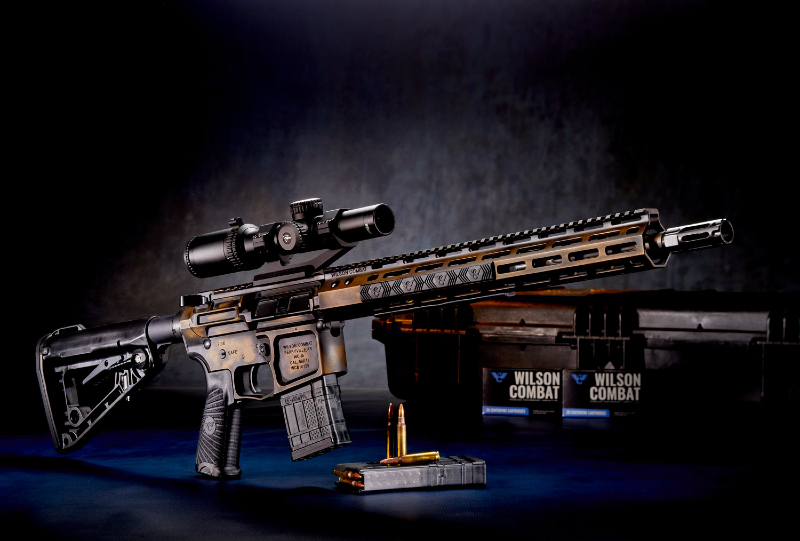The AR-15 is a gun most people are familiar with by name if nothing else. After all, over the years it’s become perhaps the most popular, high-selling rifle platform in the United States. It’s frequently depicted simply as a black rifle and used for everything from self-defense to hunting. There’s a great deal about the AR-15 platform you might not know, so we’ve put together this guide to help out.

What is an AR-15?
An AR-15 platform rifle is a lightweight, gas-operated, semi-automatic rifle with a rotating bolt. It’s manufactured in a wide array of chamberings and is designed to be portable and highly customizable. According to Forbes, there are more than 20 million AR-15s in the United States, and it’s likely the number is higher than that. This is, after all, the rifle often referred to as America’s Gun.
Who Invented the AR-15?

Eugene Stoner invented the AR-15 in 1956 as a lighter-weight version of the AR-10, which he designed first. It was 1945 when Stoner went to work for a machine shop and honed his trade as a design engineer, and by 1954 his skills had advanced him to chief engineer at ArmaLite. One minute yet important detail is that ArmaLite was a division of the Fairchild Engine and Plane Corporation; today ArmaLite is known for its small arms engineering, and understandably so.
The invention of the AR-15 was prompted by the United States military. Following World War II, the military understood that it needed better firepower than its current weapons allowed. At that time, the most common service rifles included the M1 Garand, M1 Carbine, and the M1918 Browning Machine Gun. During the initial military trials, a number of rifles were submitted for consideration including Springfield Armory’s T44E4 and T44E5, both chambered in 7.62x51mm NATO as requested. The military ultimately chose Springfield’s rifle, labeled it the M14, and tried it out.

In the field, the M14 failed rather dramatically. It was used in combat in the early stages of the Vietnam War, and it turned out to be ill-equipped to stand up to the capabilities of the enemy’s AK-47. There was also the issue of control during full-auto; apparently, the soldiers had a lot of trouble handling the M14.

The AR-10, which was the predecessor of the AR-15, had already been submitted to the military trials, but Stoner continued working on it even after the military chose Springfield’s rifle. Some of the unique features of the original AR-10 included:
- Straight-line barrel and stock
- Forged aluminum alloy receivers
- Phenolic composite stock (phenolic is a substance made from layers of resin and other materials such as cloth or paper)
With the failure of the M14 as a combat-ready weapon, the military decided to go back to the AR-10 after all. However, they decided they wanted the AR-10 platform…smaller. Enter the AR-15.

U.S. Patent 2,951,424 for the AR platform, titled “Gas Operated Bolt and Carrier System” stated:
It is an object of this invention to provide a gas system which is lighter and less expensive to produce because of its simplicity than the present gas systems now used in automatic rifle mechanisms.
It is another object of this invention to utilize the energy of the expanding gas developed by the firing of the weapon, for actuating the automatic rifle mechanism directly by use of a metered amount of the gas coming from the barrel. This invention is a true expanding gas system instead of the conventional impinging gas system. By utilization of a metered amount of gas from the barrel, the automatic rifle mechanism is less sensitive to different firing pressures caused by variations in the propelling charge. It is therefore still another object of this invention, to provide a rifle mechanism which is not affected by variations in the propelling charge.
A further object of this invention is to provide smoother operation and longer life of the working parts of the automatic rifle mechanism. Since, in this invention, the actuating force is transmitted directly down the center line of the barrel and the bolt mechanism to the shoulder of the shooter, all of the of]? center loads found in most other types of gas actuated Weapons are eliminated. It will therefore be obvious because of this factor that another object of this invention is to cut down on climb which occurs during automatic firing operations.

In 1957, General William Wyman, who was at that time a commander for the U.S. Continental Army Command—otherwise known as CONARC—made a request for a smaller caliber, lighter-weight combat rifle. That’s where the 5.56 NATO actually got its start, and with the failure of the M14, the military circled back to consider Wyman’s request.
As all this was going on, ArmaLite’s team of engineers was sizing down the AR-10 to create the AR-15. By 1959 they’d decided to sell the rights to both the A-10 and the AR-15 to Colt, and Robert Fremont, who’d played a key role in the design of both guns, went with them. Fremont joined Colt to oversee the production of the rifles and did just that for some time.
Interestingly, the first AR-15 rifles produced by Colt weren’t sold to Americans at all but to the Federation of Malaysia, which we simply call Malaysia, today.
In 1961, Eugene Stoner himself decided he was done with ArmaLite and made the move to become a consultant for Colt. It only made sense considering Colt owned the rights to his patented gas system. As this happened—firearms history makes the details a little murky, so we don’t know if it was before, after, or during—the U.S. Air Force finally tested out the AR-15 platform. They liked it enough to order 8,500 AR-15 rifles from Colt. From there, the AR platform only gained popularity.

It’s important to mention that the AR-15 rifles that went to the military were actually M16s with full-auto capabilities. The rifles civilians get are semi-automatic AR-15s, not select-fire, full-auto M16s. This is an important distinction. It was 1963 when the AR-15 was morphed into a full-auto military rifle and named the M16.
It took some time for the military to agree to let go of the M14 and in the end, it was a choice spurred on by their losses in Vietnam. The M16 was fine-tuned specifically to battle the AK-47, after all, making it a logical choice as a duty rifle. By 1965, the M16 was the official duty rifle of the United States military. For context, the Vietnam War ran from 1955 to 1975.
As for the semi-automatic AR-15 rifles that civilians can purchase without a lot of additional paperwork and enormous expense, those have been trickling into the market since 1964 through Colt. In 1977, Colt’s patent on the AR-15 platform expired, allowing other manufacturers to design and market their own AR-15-style rifles. The term “AR-15” remains a registered trademark under Colt’s name. This is why although there are endless AR-15 style rifles on the market from manufacturers other than Colt, they’re officially branded under other names. For example, the AR-15-style rifles sold by Daniel Defense have model names such as V7, MK18, and V9.

Are AR-15 Rifles Assault Rifles?
No, AR-15 rifles are not assault rifles. In fact, even the Bureau of Alcohol, Tobacco, Firearms, and Explosives (BATFE/ATF) generally doesn’t refer to guns in general as assault rifles. What they do call the Colt M16, which is the military rifle often confused with the AR-15 by the media, is a “machine gun.” Under that heading, the ATF classifies the gun as a machine gun due to its being select-fire (meaning it has full-auto capabilities).
As for assault rifles, there is an ATF listing for the AK Assault Rifle under their Firearms Guide—Identification of Firearms—Section 2, that defines that rifle as:
Classification: Machinegun
Distinctive Characteristics: Selective fire weapon. May be encountered with or without bayonet, with wooden stock or folding metal stock. Used by Soviet Bloc countries and may be designated also as AKM, Type 56 (China), Type (58 N Korea), MPIKM E Germ., or RPK, TARIQ (IRAQ) depending on the country of origin.
Special note: Commercial semi-automatic variations are currently being imported s [sic] and are NOT classified as machine guns.
Rate of Transfer Tax: $200
As made clear by the ATF and other governing bodies, in order for a firearm to be classified as a machine gun, or an assault rifle, it must have select-fire capabilities. The AR-15-style rifle sold to civilians is semi-automatic and does not have the ability to fire in full-auto mode.
What Does “AR” Mean?

The “AR” designation in the AR-15 name stands for ArmaLite Rifle. That was the manufacturer Eugene Stoner worked for when he designed the platform, so it became part of the gun’s name.
What Calibers Does the AR-15 Rifle Come In?

The good news is that the AR-15 rifle comes in more calibers than can easily be listed. This is a lengthy, inclusive list, but it’s not meant to be exhaustive.
- 17 Mach IV
- 17 Remington Fireball
- 17-223
- 20 Practical
- 22 Nosler
- 22 PPC
- 204 Ruger
- 222 Remington
- 223 Remington
- 223 Winchester Super Short Magnum (WSSM)
- 224 Valkyrie
- 24 GPC
- 243 LBC
- 243 Winchester Super Short Magnum (WSSM)
- 25 Winchester Super Short Magnum (WSSM)
- .25-45 Sharps
- .30 American
- .30 Carbine
- .30 Remington AR
- 300 OSSM
- 300 AAC BlackOut
- 300 Whisper

- 300 HAM’R
- 350 Legend
- 375 SOCOM
- 40 Smith & Wesson
- 45 Automatic Colt Pistol (ACP)
- 450 Bushmaster
- 458 SOCOM
- 499 LWRC
- 50 Action Express
- 50 Beowulf
- 56x45mm NATO
- FN 5.7x28mm
- 6mm ARC
- 6mm Dasher
- 6x45mm
- 5 Grendel
- 8x39mm
- 8mm Remington SPC
- 62x40mm Wilson Tactical
- 92x33mm Kurz
- 9x19mm Parabellum
- 9x39mm
- 10mm Auto
In addition, there are AR-15 style rifles chambered in the following rimfire cartridges:

- 17 Hornady Magnum Rimfire (HMR)
- 17 Mach 2
- 17 Winchester Super Magnum (WSM)
- 22 Long Rifle (LR)
- 22 Magnum Winchester Rimfire (WMR)
Wildcat cartridges meant for the AR-15 style rifle are created on a regular basis. Sometimes they gain enough traction to become recognized by SAAMI (Sporting Arms and Ammunition Manufacturer’s Institute). A few of the AR-15 rifle wildcat cartridges include:

- 22 Grendel
- 257 Ocelot
- 25 GPC
- 26 GPC
- 27 GPC
- 277 Wolverine
- 28 GPC
- 30 GPC
- 30 Sabertooth
- 338 SOCOM
- 338 Spectre
- 357 AutoMag
- 358 MPG
- 358 SOCOM
- 358 Yeti
- 375 Stalker
- 400 AR
- 44 AutoMag
- 44 Remington Magnum
- 44 SOCOM
- 440 Corbon Magnum
- 475 SOCOM
- 50 SOCOM

Frequently Asked Questions
Can the AR-15 rifle be used for home defense?
Yes, the AR-15 rifle is a good option for home defense use.
Can I swap AR-15 parts with parts from my AR-10?
No, the parts of the AR-15 and AR-10 are not interchangeable. They are two different platforms and the AR-10 is significantly larger than the AR-15.
Are all AR-15 rifles semi-automatic?
Put simply, yes. AR-15s are semi-automatic. In order to purchase a select-fire rifle such as the Colt M16, the buyer must pay a significant amount of money for the gun itself and fill out federal government paperwork asking permission to buy it. There is a tax stamp fee that must be paid to the government for the right to own the gun as well.
Can I shoot 5.56 NATO in my 223 Remington AR-15?
You should not attempt to fire 5.56 NATO ammo through a gun chambered specifically for 223 Remington. 5.56 NATO has a higher pressure than 223 Remington. However, you can fire 223 Remington through a gun chambered for 5.56 NATO. Also, you can fire both cartridges through rifles chambered in 223 Wylde.
Can an AR-15 kill a bear?
It’s possible to use an AR-15-style rifle on bears. Keep in mind it’s wiser to use larger calibers rather than smaller ones when hunting bigger predators like bears.
Can an AR-15 rust?
Most AR-15 rifles have a rust-resistant finish. However, anything that’s made of metal can potentially rust, so it is possible for an AR-15 to rust under the right conditions.
Can an AR-15 explode?
As a general rule, AR-15 rifles do not explode. Under extremely rare circumstances it’s possible for an AR-15 rifle to suffer a catastrophic failure that involves internal-force damage to the receiver and/or barrel. In those cases, typically either the wrong cartridge was forced through the gun or the user was using improperly loaded hand-loaded ammunition.
Can an AR-15 be chambered in 308 Winchester?
No, the AR-15 rifle cannot be chambered in 308 Winchester. If you want an AR-platform rifle chambered in 308 Winchester, you’ll have to get an AR-10, which is a larger gun.
What barrel length does the AR-15 have?
Barrel length varies on the AR-15 platform. It might be as long as 24 inches or as short as 16 inches, but any barrel under 16 inches that is mounted on a rifle is considered an SBR—short-barreled rifle—and must be approved and paid for according to the National Firearms Act. Guns with barrels shorter than 16 inches that are not made to be mounted to the shoulder, meaning they have either a buffer tube or stabilizing pistol brace instead of a stock, are not considered SBRs.


